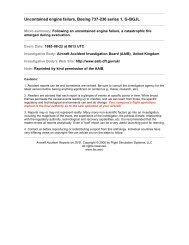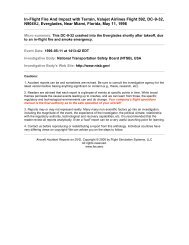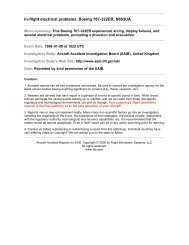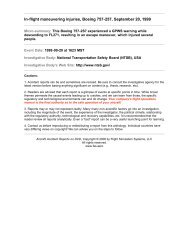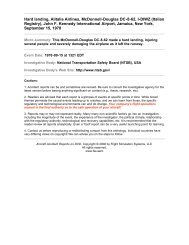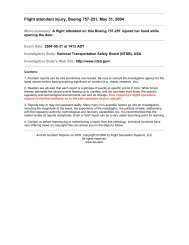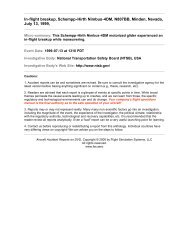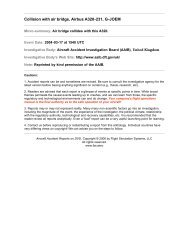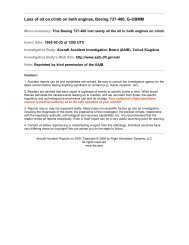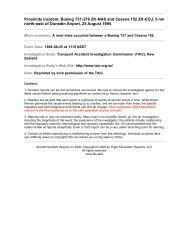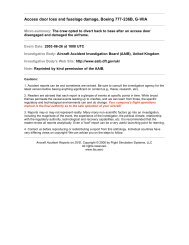Executive Summary - Fss.aero
Executive Summary - Fss.aero
Executive Summary - Fss.aero
Create successful ePaper yourself
Turn your PDF publications into a flip-book with our unique Google optimized e-Paper software.
main cause of death, thereby becoming the main reason for the incapacity. The plum<br />
residues found in the throat of the pilot was shifted during emergency rescue or the<br />
moving of the pilot. The residue of the plum was not the main cause of his sudden<br />
death.<br />
2.2 Analysis of Physical Examination<br />
2.2.1 The Examination Equipments of CAA<br />
The pilot involved in the incident had undergone physical examinations five times at<br />
the Aviation Medical Center of CAA. Of these examinations, there were three<br />
treadmill EEG examination records. The treadmill was adjustable slope type<br />
equipment and received function test including the synchronization with the simulated<br />
EEG.<br />
2.2.2 EEG Data<br />
The Aviation Medical Center used the “Civil Aviators’ Physical Examination<br />
Handbook” as basis for its handling of the examination affairs. Articles 18, 19, and 20<br />
of Chapter 2 stated the handling procedures and principles for heart murmurs, athletic<br />
EEG irregularities, and arrhythmia.<br />
In each of the EEG examinations of the pilot, no signs of irregularities or no positive<br />
reactions were found. Therefore, no further examination was made to the coronary<br />
artery occlusion and no CAT scan was conducted either. According to medical<br />
statistics, the accuracy rate of EEG in predicting coronary occlusion was 20%; of<br />
athletic EEG was about 50 to 60%; of the cardiovascular sonograms was 70% and of<br />
CAT scans was 95%.<br />
2.2.3 The high number of white blood cell (WBC) to the cause of death<br />
The Aviation Medical Center found out during each time of the physical examination<br />
that the pilot would need a re-examination due to his high number of white blood cell.<br />
The Aviation Medical Center had experienced<br />
twice of the accepting the re-<br />
examination<br />
data of the pilot examined in foreign country agencies. Only one<br />
inspection dated November 25, 1999 recommended that the pilot require having a<br />
special examination to the clinic of orthodontist in Aviation Medical Center to check<br />
the<br />
number of white blood cell. The result was no inflammation and was<br />
recommended to have a further inspection to the cause of high number of white blood<br />
cell. The Aviation Medical Center did not request for further examination or did the<br />
follow-up of this inspection.<br />
30



